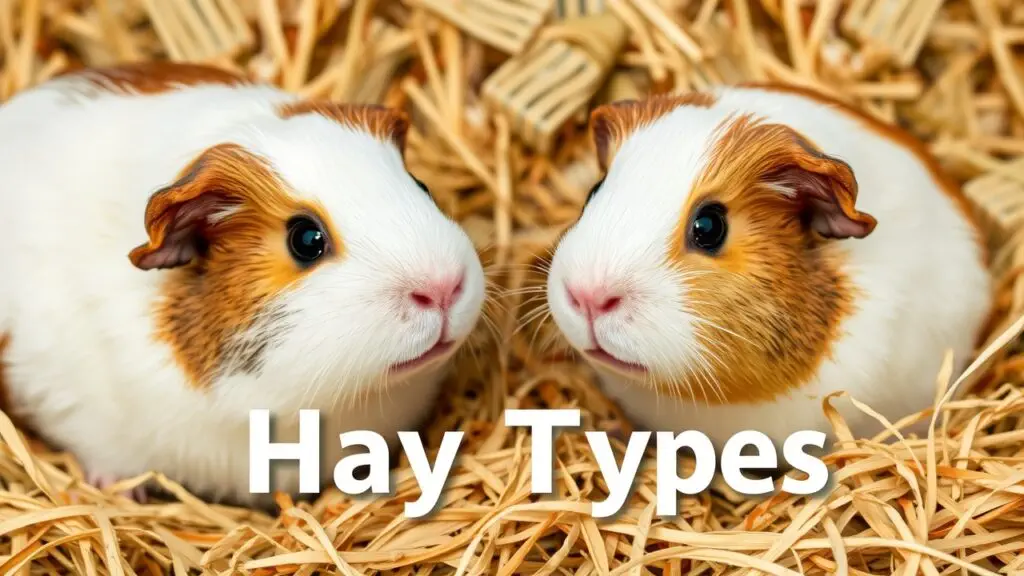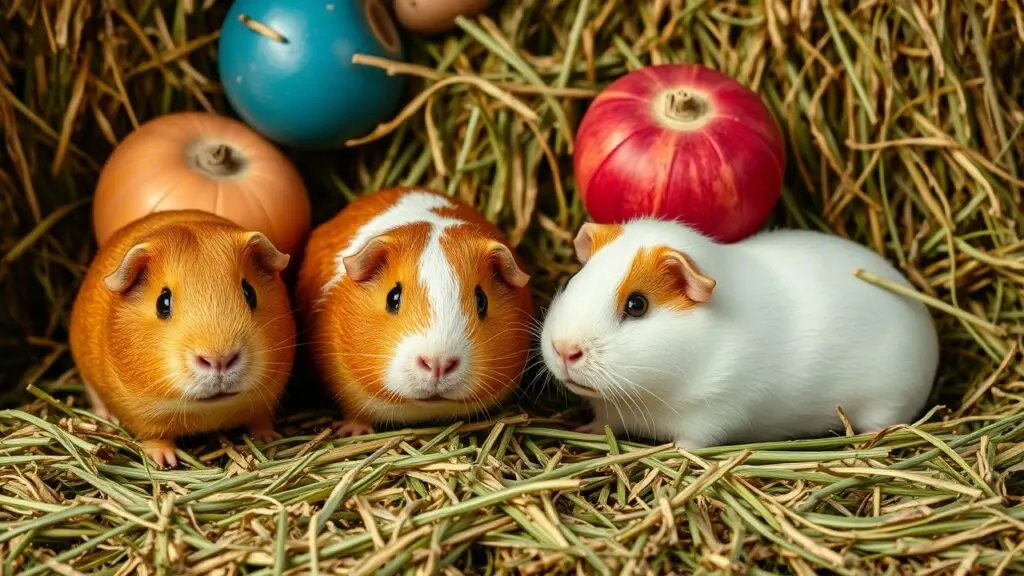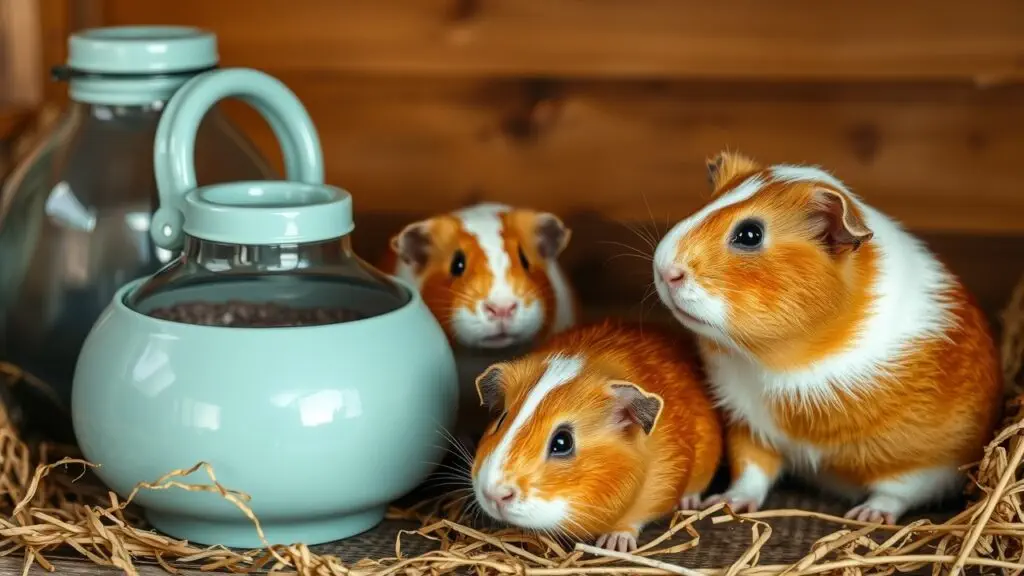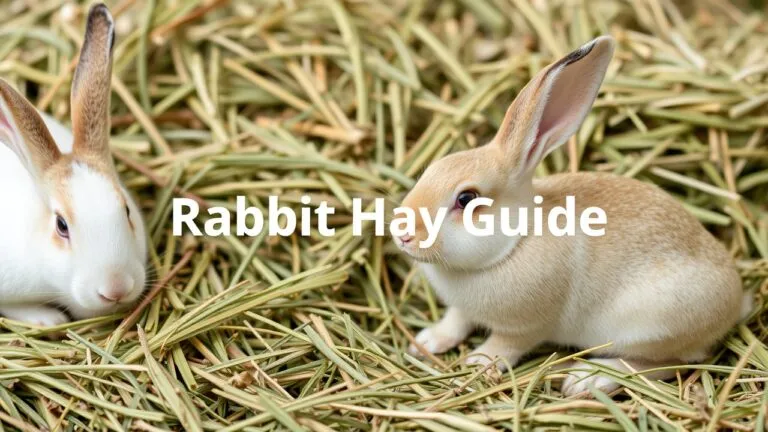Types of hay for guinea pigs are crucial for their health; Timothy hay is a staple for adults, alfalfa is better for younger guinea pigs, and other options offer variety.
Why Is Hay Essential for Guinea Pigs?

Hay is super important for guinea pigs. It gives them the fiber they need to keep their tummies working well. If they don’t get enough fiber, they might get sick. One serious problem is called gastrointestinal stasis. This means their digestion slows down or stops, which can be very dangerous.
Besides helping their digestion, hay is also good for their teeth. Guinea pigs have teeth that keep growing. Chewing on hay helps wear down their teeth naturally. If they don’t chew enough, their teeth can grow too long, which hurts and makes eating hard.
For a guinea pig to be healthy, it needs good nutrition. Hay should make up about 80% of their daily food intake. This keeps them active and supports their overall well-being.
Overview of Different Types of Hay for Guinea Pigs
There are two main types of hay that are good for guinea pigs: grass hays and legume hays.
Grass Hays: These include Timothy hay, Orchard grass, Meadow hay, and Oat hay. Grass hays are high in fiber but lower in protein than legume hays. They are best for adult guinea pigs since they help keep them at a healthy weight while giving them essential nutrients.
| Type | Fiber Content | Protein Level | Best For |
|---|---|---|---|
| Timothy Hay | High | Moderate | Adults |
| Orchard Grass | High | Moderate | Adults & Seniors |
| Meadow Hay | Variable | Low-Moderate | All ages |
| Oat Hay | Moderate | Low | All ages (in moderation) |
Legume Hays: The most common one is Alfalfa. It has more protein than grass hays because it’s richer in nutrients. While it’s good for young or pregnant guinea pigs who need extra energy, adult guinea pigs should only eat a little bit of it. Too much protein can make them gain weight or cause urinary problems.
When picking the right type of hay based on age or health:
- Babies (under 6 months): They can have both grass hays and some alfalfa.
- Adults (6 months – 5 years): They should mostly eat grass hays.
- Seniors (over 5 years): They might need softer options like Orchard grass if they have dental issues but still need plenty of fiber from grass.
Understanding these types helps you choose the right hay for your pet’s needs at different stages of life.
Common Types of Hay Suitable for Guinea Pigs
What Is Timothy Hay?
Timothy hay is one of the best grass hays for guinea pigs. It is high in fiber and low in calcium, which makes it a great choice for their diet. The high fiber helps with digestion. This is super important for keeping your guinea pig healthy. Plus, Timothy hay promotes good dental health. Chewing it helps wear down their teeth naturally.
For adult guinea pigs, Timothy hay offers big benefits for weight management too. Since it’s low in calories and rich in fiber, it helps them stay at a healthy weight and prevents obesity.
When you buy Timothy hay, look for trusted brands like Oxbow or Kaytee. They are known for providing high-quality options.
Orchard Grass Hay Explained
Orchard grass is another favorite among guinea pig owners. It has a bit more protein and calcium than Timothy hay. Many guinea pigs love the sweet taste and softer texture of orchard grass.
If your guinea pig is picky about food, orchard grass might be just the thing to get them to eat more happily.
Meadow Hay Characteristics & Risks
Meadow hay is different from other types because it has a mix of various grasses and plants. This can lead to changes in nutrient levels, including calcium. If you’re not careful, some meadow hays might not be good for all guinea pigs.
To pick safe meadow hay blends, check the package for details on what types of grasses are included. Make sure there are no harmful additives or mold before giving it to your pet.
Alfalfa Hay Uses & Limitations
Alfalfa hay is known for being high in protein and calcium. It’s best for baby or pregnant/lactating guinea pigs since they need those extra nutrients. For young ones still growing or mothers needing extra nutrition during pregnancy or nursing periods, alfalfa can be helpful.
However, giving alfalfa hay to adult guinea pigs can cause health problems like urinary issues from too much calcium intake. Always think about your guinea pig’s age and condition when choosing their hay.
Specialized Hays and Lesser-Known Varieties
Oat, Ryegrass, Brome Hays – Are They Safe?
When choosing hay for guinea pigs, it’s super important to know which types are safe. Oat hay, ryegrass hay, and brome hay can all be good choices if picked right. Each has its own special nutrients that can help your pet.
Oat hay is safe for guinea pigs. It gives them lots of fiber, which helps with digestion. It also has some protein. Ryegrass hay is another good option. It’s easy for guinea pigs to digest and is a nice addition to their food. Brome hay is liked by many owners because it’s soft and tasty for pets.
Make sure that any new hay you give your guinea pig is fresh and free from mold or dust.
Nutritional Overview of Oat Hay
Oat hay is a standout choice among hays for guinea pigs due to its special nutrition:
- Fiber Content: Oat hay has a high fiber level (around 30% or more), which helps their tummy work well.
- Protein Levels: The protein in oat hay usually ranges from 8% to 12%, making it a solid pick for active guinea pigs.
- Calcium Levels: Oat hay has less calcium than alfalfa (about 0.4%), so it supports healthy bones without causing urinary problems from too much calcium.
This mix makes oat hay great for adult guinea pigs who need balanced food without too many calories.
Benefits and Uses of Ryegrass Hay
Ryegrass hay brings a bunch of benefits that make it popular with guinea pig owners:
- Digestibility: This grass is easy to digest, helping keep their guts healthy.
- Nutritional Value: It has the right amount of fiber needed for good digestion.
- Variety in Diet: Adding ryegrass makes their meals more interesting, keeping them from getting bored with the same food.
In short, ryegrass can be a good addition or replacement alongside other hays like Timothy or orchard grass.
Characteristics of Brome Hay
Brome grass has some unique traits that are great for feeding guinea pigs:
- Nutritional Value: Brome offers moderate protein (around 10%) but shines in providing fiber that’s important for digestion.
- Suitability: Its softer feel makes brome a favorite among picky eaters while ensuring they get the nutrients they need—especially during growth or recovery times.
Brome is also gentle when introducing new hays into their diet since most pets will enjoy its flavor.
Potential Risks Associated with These Hays
While these specialized hays are beneficial, there are some risks you should know about:
- Nutrient Variability: Not every batch of hay has the same nutrients; they can change based on where and how they grow.
- Allergies & Sensitivities: Some guinea pigs might develop allergies over time; pay attention to how they react when you introduce new hays.
- Mold Contamination: Always check that the hay is fresh; moldy or dusty hays can lead to serious health issues like breathing problems.
By understanding these risks, you can give your furry friend only the best options that fit their needs!
Hay Allergy Mitigation Options
If you see signs of allergies from certain hays—like sneezing or itching—think about switching to dust-free alternatives made for sensitive pets:
- Look for “dust-free” products at pet stores or online to help reduce allergens in typical hays!
- Introduce changes slowly so you can see how each switch affects your pet’s comfort level throughout this process!
By being careful about what goes into their meals—including picking the right kinds—you’ll help your guinea pig live happily and healthily!
Choosing the Right Type Based on Age & Health Needs

What’s the Best Choice by Age Group?
When picking hay for your guinea pig, think about their age and health needs. Baby guinea pigs, or pups, need lots of protein and calcium because they’re growing fast. Alfalfa hay is perfect for them since it has these nutrients.
As guinea pigs grow up and become adults, their food needs change. Adult guinea pigs do best with grass hays like Timothy or orchard grass. These hays have less protein and calcium than alfalfa but are high in fiber. This helps keep their teeth healthy and controls their weight.
Senior guinea pigs may have special health issues, like trouble digesting food. For them, softer hays that are easy to chew can help a lot. It’s good to watch how they eat and change their diet if needed.
Special Considerations During Pregnancy/Nursing
Pregnant or nursing female guinea pigs need extra food to stay healthy. They should eat good legume hays like alfalfa because it gives them more protein and calcium. This helps both the mom and her babies grow strong. Keep an eye on how they feel during this time; good food is key for everyone’s health.
Adjusting Choices Based On
Weight Management Goals
Keeping your guinea pig at a healthy weight is super important! Some hays can help with this by being high in fiber but low in calories. Grass hays like Timothy are great since they help digestion and keep weight down without extra calories.
Digestive Issues
Guinea pigs can have tummy troubles sometimes, like bloat, if they eat too much rich food or the wrong stuff. Giving them plenty of fibrous grass hay can help digestion and stop these problems from happening.
Urinary Stones
Some guinea pigs might get urinary stones from eating too much calcium. This often happens with alfalfa if it’s given too much over time. To avoid this problem while still providing good nutrition, use grass hays with less calcium. They still give essential nutrients without increasing the risk of stones forming.
Identifying High-Quality Hay
When you’re looking for hay for your guinea pig, it’s super important to pick high-quality stuff. Good hay keeps your pet happy and healthy. Here are some tips on how to find fresh, nutritious hay.
Key Indicators of Fresh, Nutritious Hay
First off, good quality guinea pig hay should look green and smell nice. You wanna avoid hay with brown or yellow spots because that might mean it’s old or was stored badly. Dust-free hay is also a sign that it’s top quality. Too much dust can hurt your guinea pig’s breathing.
Color of Hay
The color of the hay matters a lot. Fresh grasses like Timothy or Orchard Grass should be bright green. If the hay looks dull or has brown patches, it could be old or not stored right. Spotting poor quality hay early helps keep your furry friend safe.
Smell and Texture
Next up is the smell! Fresh hay has a sweet scent, kinda like freshly cut grass. The texture should be soft but not too crumbly. You want it to feel nice when you touch it, but not rough.
Absence of Mold or Dust
Moldy hay can make your guinea pig sick, causing breathing and tummy problems. Always check for mold before buying any hay. It’s best to choose dust-extracted types whenever you can since they help cut down on allergens and make the air nicer for your pet.
Storage Best Practices
Keeping your guinea pig’s food fresh is really important!
Maintaining Freshness Through Proper Storage Techniques
To keep hay fresh, store it in a cool and dry place away from sunlight. Sunlight can hurt its nutrients over time. Try using breathable containers like cardboard boxes or mesh bags instead of plastic ones because plastic can trap moisture.
Protecting Hay From Moisture and Pests
Moisture can lead to mold, which is bad news for your pet. Bugs might also get into badly stored hay! Make sure containers are sealed tightly after use to keep out moisture and pests.
Recommended Storage Containers for Guinea Pig Hay
For the best results, use airtight bins meant for animal feed if you can find them; if not, clean cardboard boxes work just fine! Just don’t pack the hay too tightly—air needs to flow through so it stays fresh longer.
How Much Hay Should Your Guinea Pig Eat?
Daily Hay Intake Guidelines
Guinea pigs need a lot of hay. It’s best to give them unlimited access to good quality grass hays like Timothy or Orchard Grass. This helps them eat as much as they want, which is key for their digestion and keeps their teeth from getting too long.
Watch how much hay your guinea pig eats every day. If they start munching less than normal, it could mean they have health problems. Issues like dental pain or tummy troubles might be why they aren’t eating. So, keeping an eye on their hay intake is super important!
Hay Feeding Methods and Tools
To help your guinea pig eat well, you can use hay feeders or racks. These tools make it easier for them to grab fresh hay while keeping it clean and off the ground. Plus, using these can cut down on waste.
Make sure your guinea pig can always get fresh and clean hay during the day. Check the feeders often to see that they are stocked with nice quality hay. This way, your furry friend can stay happy and healthy!
Addressing Picky Eating Habits

Guinea pigs can be really fussy eaters! It’s important for pet owners to understand why their guinea pigs refuse certain foods. These cute critters are herbivores and prefer fresh, high-fiber foods like hay. Monitoring your guinea pig’s hay consumption is key because dietary fiber helps keep their digestion healthy.
Why Guinea Pigs Can Be Picky Eaters?
Guinea pigs may act picky for many reasons. Their food choices can change based on texture, smell, or even bad experiences with some foods. If a guinea pig has had poor-quality hay, it might avoid similar types later on. Plus, every guinea pig has its own tastes, just like us!
Addressing Potential Causes of Food Preferences and Dislikes
To help your furry friend eat better, it’s useful to know what affects their food choices. First, look for signs of poor quality hay. Dusty or moldy hay isn’t safe or healthy. Next, learn about understanding hay labels so you can find the best options with good nutritional value. This knowledge will help you choose better food for your pet.
Strategies for Encouraging Hay Consumption
If you want to get your guinea pig to eat more hay, try offering different types while keeping them fresh and appealing. Some of the best grass hays for guinea pigs include Timothy Hay and Orchard Grass because they have high fiber that aids digestion. When introducing new hays, watch how your pet reacts. Mixing old favorites with new choices may help them feel more comfortable.
Gradual Introduction of New Hay Types
When buying hay for your guinea pig, remember that the quality can change with the seasons! Introduce new types slowly so your pet has time to adjust to the different flavors and textures without feeling overwhelmed.
Providing a Variety of Textures and Flavors
Adding premium or organic options can make meals more interesting! Different textures—from soft meadow hays to coarse timothy—can catch their attention and also provide the nutrients they need for a healthy life.
Ensuring Hay Is Fresh and Appealing
Always check the quality of the hay you give your guinea pig. Good quality hay should be dust-free and clean. Dust-free hay not only looks better but also helps promote healthier eating habits among picky eaters!
By paying attention to these factors in your care routine, you might notice improvements in what your beloved pet enjoys eating every day!
Frequently Asked Questions (FAQs) About Hay for Guinea Pigs
What are the different hay varieties suitable for guinea pigs?
Guinea pigs can eat various hay types. Grass hays like Timothy, Orchard, and Meadow are popular. Alfalfa hay is also common but is best for young or pregnant guinea pigs. Other options include Oat hay, Ryegrass, and Brome hay.
What is the difference between first, second, and third cutting hay?
First cutting hay is coarser and has more stem. It often contains higher fiber but less protein. Second cutting hay is softer and has a higher protein level. Third cutting hay is very soft with low fiber but high protein. Each type serves different dietary needs.
How can I identify good quality guinea pig hay?
High-quality hay appears green with no yellow or brown spots. It should smell fresh and be dust-free. Check for mold or excessive dust as they can harm your guinea pig’s health.
Is organic hay better for my guinea pig?
Organic hay can be a great option. It lacks harmful pesticides and chemicals. Choose certified organic sources to ensure safety for your pet.
How do I store guinea pig hay properly?
Store hay in a cool, dry place away from direct sunlight. Use breathable containers like cardboard boxes or mesh bags to keep it fresh. Ensure it stays free from moisture and pests.
How much hay should my guinea pig eat daily?
Guinea pigs need unlimited access to fresh hay each day. They should eat a variety of grass hays like Timothy or Orchard to meet their fiber requirements.
Can I buy guinea pig hay in bulk?
Yes, buying in bulk can save money and ensure you have enough supply. Look for online suppliers or local farms that sell fresh bales.
Understanding Hay Selection for Guinea Pigs
- Hay Types: Explore grass hays like Timothy and legume hays such as Alfalfa.
- Nutritional Value: Focus on protein, calcium, and fiber levels in each type.
- Hay Storage: Use airtight containers to keep moisture out.
- Hay Feeding Schedule: Offer unlimited access to maintain digestive health.
- Hay Quality Indicators: Freshness is key; look for color, smell, and texture.
- Dust-Free Options: Choose dust-extracted varieties to reduce respiratory risks.
- Special Needs Hays: Consider softer hays for seniors or those with dental issues.
- Feeding Tools: Use hay feeders or racks to keep the food clean.
- Common Hay Suppliers: Research local stores and online resources for good options.
- Seasonal Variations: Be aware that quality may change throughout the year.
This guidance helps you choose the best types of hay while ensuring your guinea pig’s health needs are met!
Related Topics
- Types of grass hays
- Types of legume hays
- Types of hay feeders
- Types of hay storage containers
- Types of guinea pig allergies
- Types of guinea pig hay brands
- Types of hay cutting (first, second, third)
- Types of guinea pig eating habits



Types of Hay for Guinea Pigs: Timothy, Alfalfa, & More